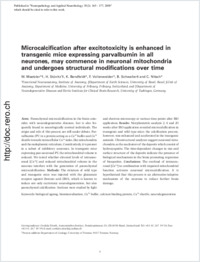Microcalcification after excitotoxicity is enhanced in transgenic mice expressing parvalbumin in all neurones, may commence in neuronal mitochondria and undergoes structural modifications over time
- Maetzler, W. Functional Neuroanatomy, Institute of Anatomy, University of Basel, Switzerland - Department of Neurodegenerative Diseases and Hertie Institute for Clinical Brain Research, University of Tuebingen, Germany
- Stünitz, H. Department of Earth Sciences, University of Basel, Basel, Switzerland
- Bendfeldt, Kerstin Functional Neuroanatomy, Institute of Anatomy, University of Basel, Switzerland
- Vollenweider, F. Functional Neuroanatomy, Institute of Anatomy, University of Basel, Switzerland
- Schwaller, Beat Unit of Anatomy, Department of Medicine, University of Fribourg, Fribourg, Switzerland
- Nitsch, C. Functional Neuroanatomy, Institute of Anatomy, University of Basel, Switzerland
-
28.06.2008
Published in:
- Neuropathology and Applied Neurobiology. - 2009, vol. 35, no. 2, p. 165 - 177
biological ageing
biomineralization
Ca2+ buffer
calcium binding protein
Ca2+ shuttle
neurodegeneration
English
Aims: Parenchymal microcalcification in the brain coincides with neurodegenerative diseases, but is also frequently found in neurologically normal individuals. The origin and role of this process are still under debate. Parvalbumin (PV) is a protein acting as a Ca2+ buffer and Ca2+ shuttle towards intracellular Ca2+ sinks, like mitochondria and the endoplasmic reticulum. Constitutively, it is present in a subset of inhibitory neurones. In transgenic mice expressing pan-neuronal PV, the mitochondrial volume is reduced. We tested whether elevated levels of intraneuronal [Ca2+] and reduced mitochondrial volume in the neurone interfere with the generation of parenchymal microcalcification. Methods: The striatum of wild type and transgenic mice was injected with the glutamate receptor agonist ibotenic acid (IBO), which is known to induce not only excitotoxic neurodegeneration, but also parenchymal calcification. Sections were studied by light and electron microscopy at various time points after IBO application. Results: Morphometric analysis 2, 4 and 20 weeks after IBO application revealed microcalcification in transgenic and wild type mice; the calcification process, however, was enhanced and accelerated in the transgenic animals. Ultrastructural analyses suggest neuronal mitochondria as the nucleators of the deposits which consist of hydroxyapatite. The time-dependent changes in size and surface structure of the deposits indicate the presence of biological mechanisms in the brain promoting regression of bioapatites. Conclusions: The overload of intraneuronal [Ca2+] in combination with impaired mitochondrial function activates neuronal microcalcification. It is hypothesized that this process is an alternative/adaptive mechanism of the neurone to reduce further brain damage.
- Faculty
- Faculté des sciences et de médecine
- Department
- Département de Médecine
- Language
-
- English
- Classification
- Biological sciences
- License
-
License undefined
- Identifiers
-
- RERO DOC 12254
- DOI 10.1111/j.1365-2990.2008.00970.x
- Persistent URL
- https://folia.unifr.ch/unifr/documents/301187
Statistics
Document views: 113
File downloads:
- pdf: 203
